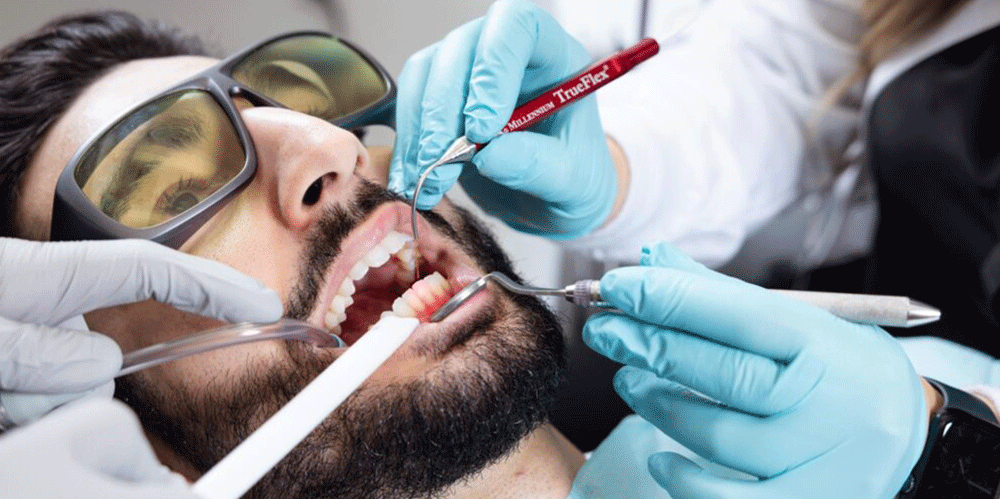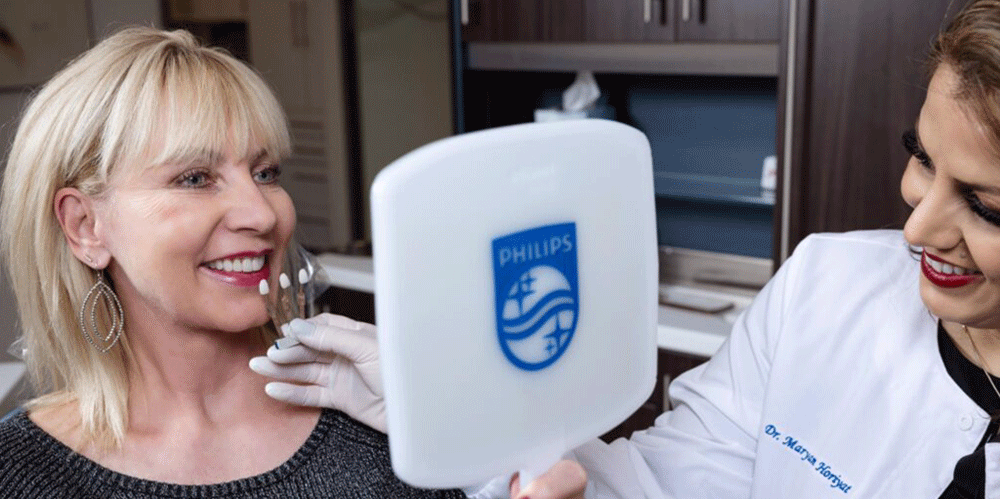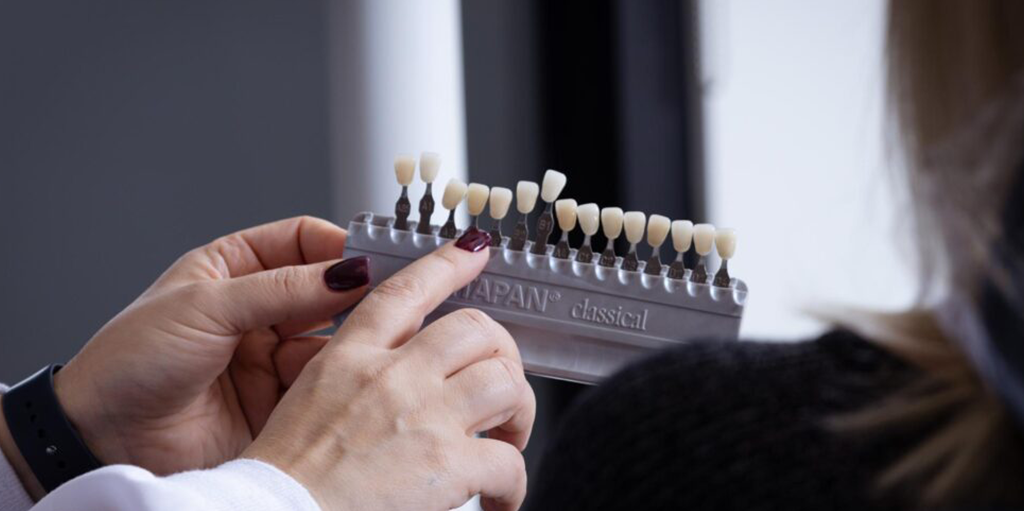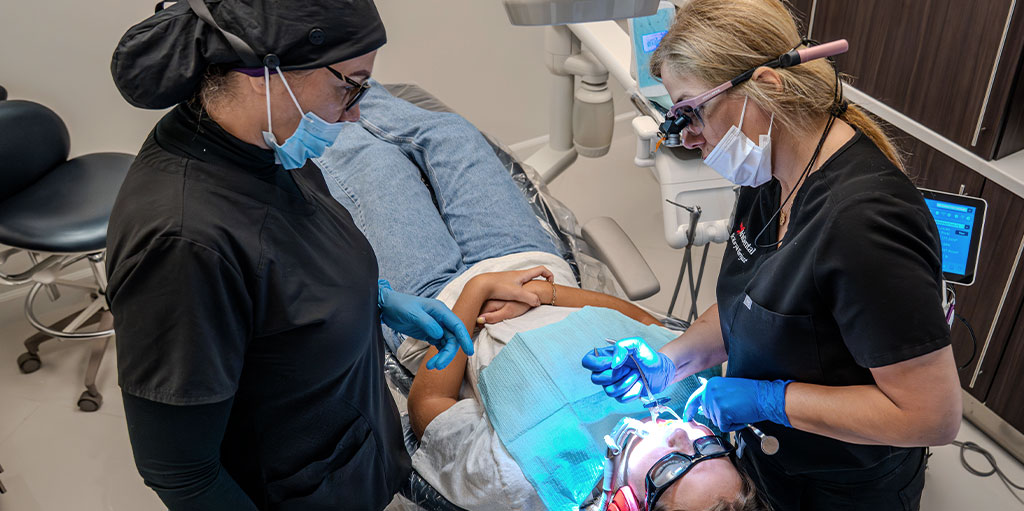
Teeth that are severely damaged or missing can be substituted in various ways. One of the most successful methods is the use of dental implants, which replace a missing tooth with an artificial one that looks and functions like a natural tooth. It requires one or more surgeries and comes with benefits, as well as risks. In this article, you will become familiar with the various aspects of this treatment process, including the types of dental implants, their care, and alternative options.
What Are Dental Implants
Dental implants are screw-like posts that are surgically implanted into the jawbone as a replacement root. A crown is placed over the screw to replace the natural tooth. Dental implants look very much like natural teeth and improve chewing function and overall oral health. You can use dental implants to replace one or more missing teeth and regain your confidence and a beautiful smile.
Dental Implants Structure
The implant structure basically consists of three parts: the Threaded post, the Abutment, and the Restoration (crown).
Threaded post
The threaded post, or fixture, is a screw that is inserted into the jawbone during a short surgical procedure using modern dental tools and digital design. The threaded post is the first portion of the implant that is inserted and acts as the root of the tooth; thus, it is conical in shape, the same as a natural tooth root. After implant placement, it takes approximately 4 to 6 months for the base to fuse with the jaw and for the gums to heal, and then the second implant component is installed.
Dental Implant Fixture Diameter
Dental implant posts are available in a range of various diameters, and the expert will choose the most suitable thickness based on the location of the implanted tooth, the condition of the patient’s teeth, and so forth; for example, for anterior teeth, a narrow or mini diameter fixture is chosen, but for posterior teeth, a thicker one is considered for this part.
The other factor in deciding the dental implant base diameter is the patient’s oral and tooth health. If the patient does not have sufficient bone density, the dentist will likely use zygomatic fixtures for dental implants. Zygomatic implant posts are longer than standard implant fixtures and are placed into the jawbone and zygomatic bones.
Implant Post Material
Fixtures are generally fabricated using titanium. Titanium is the only element that has the unique combination of strength, lightness, and biocompatibility, and is very strong and long-lasting. Titanium is also very resistant to corrosion and wear, and thus is used to manufacture implant posts.
That being said, in biological dentistry, zirconia implants are generally preferred over traditional titanium implants, which are made of a strong, non-metallic ceramic material. The implants are biocompatible, meaning they have less likelihood of causing allergic reactions or sensitivities, and are also believed to integrate into the jawbone nicely. Some of the reasons why zirconia is chosen are that there are fewer allergic reactions, better aesthetics as it is white, and less plaque buildup. More on this later!
Abutment
Abutment is another of the three components of a dental implant. The abutment refers to a small screw of titanium or ceramic that spans the fixture and tooth crown, i.e., one part of it is screwed into the implant post and the other part is secured to the denture or crown. The abutment may be inserted simultaneously with the implant post or can be attached to the fixture once osseointegration has occurred, but in most cases, this implant component is attached after a couple of months so that the fixture has enough time to heal and become one with the jawbone.
In order to place the abutment, the professional dentist will then surgically incise the gum again, examine the area over the dental implant, and cement the new abutment. The gum should heal first before other components of the dental implant can be fitted.
Restoration
Of all the components of a dental implant, the only one visible is the restoration. The restoration can be a crown, bridge, or implant-supported denture. Restorations are made of all kinds of materials, such as porcelain or ceramic, and screwed in or cemented to an abutment.
Most single-tooth implants have three components, but there are two-piece implants. This implant is designed in a way that the post and abutment are one unit. With this method, the implant prosthesis is placed on top of the implant.
What Are Dental Implants Made of?
Generally speaking and putting all the exceptions aside, a dental implant with a well-known safety profile can be made of the following:
1. Titanium and Titanium Alloys
2. Zirconia or Zirconium Oxide
3. Gold Alloys
4. Cobalt-Based Alloys
5. Ceramic Materials
As you might have already guessed, some of these options are more luxurious than the rest and hence are not as common as titanium, zirconium oxide, or zirconia dental implants.
You can also read more about what dental implants are made of in more details by checking this blog out!
Titanium vs. Zirconia
There are obvious reasons why dental implants are made up of such a variety of materials more importantly why there are made of zirconia. To be very short and concise about this, you need to know that zirconia has some magical properties that other metal implants black. For example, zirconia is known to be extremely biocompatible compared to titanium. This means that is zirconia dental implant will blend in much better with your jawbone and your gum resulting in zero toxicity, zero buildup of bacteria and microorganisms, and of course zero chronic diseases.
The truth being told the presence of chronic diseases due to poor and non-holistic dental treatments is overshadowed by many dentists and organizations, while everybody knows that quite a few of the chronic diseases people have been facing, which are often left undiagnosed, actually come from non-biocompatible dental material and appliances used in dental offices.
So why is zirconia so much better than titanium? Generally, speaking titanium and titanium alloys have been used to fabricate various implantation and fixation systems across the medical and dental field. As you may already know, titanium has a grayish metallic color zirconia is white. After decades of research, titanium dental implants have originally become a cornerstone of modern prosthetic restoration after tooth loss in Dentistry.
However, modern studies have shown that titanium dental implants can be a leading factor in triggering the immune system and causing multiple health issues at the same time. They are also known to be very limiting when it comes to aesthetics and cause a very annoying metal taste in the mouth.
After excessive studies, the scientists realized that the dream material for a dental implant is zirconium. Zirconium is a transition metal, that is true, but when zirconium gets oxidized, zirconium oxide or zirconia, it becomes completely ceramic with absolute zero metal characteristics
In the video below, Dr. Horiyat has extensively, explained the differences between zirconia and titanium implants so make sure to watch that one before moving on.
To wrap things up on this front here are ten reasons why you should always go for zirconia dental implants:
1. Ultra-Biocompatible – No metal, no reaction, and No toxicity Vs. Titanium implants are only bio-tolerable for some patients. (Read more about this here.)
2. Great Epithelial or Gum Attachment so low gum recession around Zirconia dental implants
3. Low Plaque Accumulation around Zirconia dental implants- Unlike titanium dental implants that collect plaque and bacteria easily
4. Great White Color and esthetics
5. Corrosion Resistance in the moist oral environment- No metal so obviously no corrosion
6. Zirconia is ceramic and Metal-free- So No Metal Taste- Some patients complain about a metal taste with their Titanium dental implants.
7. Favorable Mechanical Properties, such as
8. Low thermal conductivity- they tend to prevent heat transfer and have fewer free electrons, unlike titanium dental implants.
9. Improved flexural strength and fracture toughness- so they do not fracture easily.
10. Zirconia implants have effective osseointegration or bone formation as good as titanium.
To turn you away from zirconia implants, many dentists may claim that zirconia is not as strong as titanium when it comes to dental implants. While this fact may be correct mechanically, it is absolutely not applicable when it comes to dentistry. Numerous data and research have shown that zirconia dental implants have adequate fracture resistance, and toughness, and are just as good and capable as titanium dental implants are.
Dr. Horiyat firmly states: “In my personal clinical experience after several years, I have never had any patient breaking their Zirconia dental implants. I have seen bone loss around Titanium implants but no significant or obvious bone loss around my Zirconia dental implants even after several years.”
Why Should You Avoid Titanium Dental Implants?
Besides everything that we have discussed so far, titanium dental implants, come with other problems and side effects. The most important one is that over time titanium dental implants, which are metal alloys will corrode in the moist environment of the oral cavity. this means that there will be metal released into your gum and the bone which could lead to severe medical conditions and allergic reactions, including automatic diseases, hypersensitivity, chronic fatigue, inflammation of the bone, and even brain fog. Yes, that is right! Your brain fog may be due to your oral hygiene. We highly recommend you watch the video below and then move forward.
It is important to mention that some of these medical conditions led by titanium dental implants are irreversible so why not just opt for biocompatible, metal-free, dental implants, a.k.a. Zirconia implants?
What about titanium implants in other parts of the body?
That is an excellent question! Titanium implants have proven to be a cornerstone in creating prosthetics for other parts of the body so why not for the teeth as well? The answer is very simple. Having your titanium implant anywhere else in your body means that the implant is actually placed within, the tissues or the bones.
When it comes to dental implants, it is true that the implant placed inside the bone and the gum however is still in contact with the moist environment of your mouth and acidic oral environment which is also likely to include plague and bacteria around it. This means that you’re titanium implant will be acting differently in your mouth compared to the rest of your body.
Why Do Most Dentists Prefer Titanium Dental Implants?
Now that we have learned so much about the superiority of zirconia dental implants, and the toxicity of titanium, the question is why do most dentists prefer titanium dental implants?
There were several answers to this question, but the most important and obvious one is that all conventional dentists are predominantly taught to place titanium implants. This means they have not received exclusive training for placing a zirconia dental implant. This also likely means that their offices are not equipped with suitable tools and gears such as drills and drives to install these implants.
Another reason for this is that placing zirconia dental implants is not only quite difficult but also quite expensive, especially for placing only a few dental implants occasionally.
Types of Dental Implants
Types of dental implants can be categorized based on the tooth’s position relative to the jawbone, length and diameter, implant material, manufacturer brand, and aesthetic appearance. The most appropriate option among such types of dental implants is selected by the implant expert based on the condition of the patient’s mouth and teeth. Types of dental implants based on the position of the implant in relation to the jawbone are endosteal, zygomatic, and subperiosteal implants, as explained below.
Endosteal Implants
Endosteal implant is the most common type of dental implant, which fits into the jawbone like a screw. However, you need to have a healthy jawbone and gums to use this implant method. Sometimes, bone grafting may be required to create a healthy and strong base for the implant to be successfully placed. This type of implant requires less time for the gums to attach to the implant and create a strong base, in comparison with other implants.
Subperiosteal Implants
This option is not as common as endosteal implants and is used for individuals with special needs. Subperiosteal implants are used when there is not enough bone density for endosteal implants. The implant is placed in the gums. So, it is not placed inside the bone but above it. In this process, the professional surgically places a metal frame under the gums, where the implant would be placed.
Zygomatic Implants
Zygomatic implants are a third choice, but are less commonly used in dentistry now. These types of implants are reserved only for cases where there is major loss of bone and bone augmentation cannot be applied. Zygomatic implants include a more complex surgery and are inserted into the zygomatic bone (cheekbone) instead of being placed in the patient’s jawbone.
Choosing the Best Type of Dental Implant
To choose the best option, you need to trust your specialist’s diagnosis and recommendation. Your dental professional might choose the best type of implant for you based on the condition of your teeth, the density of your jawbone, and your own needs. A team of the most skilled and professional specialists of Aria Dental will help you choose the best method based on your circumstances.
What Are Dental Implants Treated For
Dental implants are used when a person has lost one or more teeth for any reason and needs a permanent, natural replacement instead of a denture or bridge. The following are some of the most common uses for dental implants:
- Severe cavities that are unable to be treated with a filling or a crown.
- Teeth that never grow in (anodontia).
- Cracked or broken teeth that cannot be repaired.
- Tooth loss due to gum disease.
- A single missing tooth or multiple missing teeth.
If you have good general health and jawbone, you can have a great smile and healthy teeth with the help of dental implants.
The Benefits of Dental Implants
Dental implants work perfectly and look like natural teeth. The above 97% success rate for ten years demonstrates the long life and durability of the implant. Reducing the risk of decay and endodontic problems of adjacent teeth, improving bone preservation in the edentulous area, giving a sense of self-confidence, improving the quality of speech, and reducing sensitivity of nearby teeth are some other benefits of this treatment method. Finally, after the treatment period is complete, you can easily enjoy eating your favorite foods using your new teeth and regain your beautiful appearance.
What Is The Best Brand For Dental Implants?
In today’s world, few dental implant brands are considered leaders in the global dental implant market. Among them is the Swiss brand Straumann. The world’s No. 1 manufacturer, Straumann, is the originator of many technologies and techniques in implantology because Straumann dental implants Guarantee the Device’s Reliability and Ensure its Durability.
Another reason why this brand of implant is so popular with implantologists is the predictability for both their Zirconia and Titanium implants.
Another Zirconia Swiss brand dental ceramic implant is Z-System with great options for Restorability and Less Impurities compared to other Zirconia dental implants shown in recent research for elemental analysis of Zirconia dental implants. Z-System exclusively Makes Zirconia Implants and no Titanium implants; so, their focus and research are only on Zirconia or ceramic implants.
Based on my clinical experience, these two implant systems have been my favorite dental implants, but I am very sure other dental providers might have different experiences.
The Dental Implant Procedure
There are several phases of the dental implant procedure, from the removal of the troubled tooth to the crowning. The procedure is done in steps, and your body has to go through a healing process before advancing to the subsequent phase. The molar, canine, and front tooth implant procedures have 3 significant steps: implant placement, bone healing and growth, and crown placement, but additional stages may be required depending on the patient’s condition.
Get Prepared
Before the treatment process begins, you should first consult with your doctor. The doctor will examine your teeth thoroughly and may do dental X-rays too. Your doctor will also ask you about your medical history. If you’re currently taking any medications or have any medical conditions, inform your expert.
Lastly, a personalized treatment plan will be developed for you based on the condition of your jaw and teeth. You may be given local anesthesia, sedation, or general anesthesia for the surgery. You can discuss this with your dentist beforehand.
Placing The Dental Implant
Sometimes the patient’s jawbone isn’t sufficient and requires a bone graft. In this case, before implant placement surgery, a bone graft procedure is performed, typically using the patient’s own healthy bone (autogenous bone) from a different site, or other biocompatible bone substitute materials. After the bone graft has healed and integrated with the surrounding jawbone (a process that typically takes several months), the dental implant is then surgically placed. This procedure is usually performed under local anesthesia. Your oral surgeon will incise your gum to expose your jawbone and will create a hole in your jawbone to place the threaded post.
Healing Phase
After implant placement, the crucial osseointegration phase typically takes anywhere from 3 to 6 months. During this period, the implant and jawbone gradually fuse with each other, creating a healthy and durable base for the final prosthetic tooth. To protect the implant and guide healing of the gum tissue in the area around the implant, a healing abutment (or healing cap) is normally placed on the implant during this period. The exact duration of this healing phase can vary slightly, depending on an individual’s overall health and the body’s natural healing capabilities.
Attach The Final Crown, Bridge, Or Denture
Once your jawbone is healed and united with the implant fixture (the threaded base), the abutment is attached to the implant, and a temporary crown is usually placed on it. This crown remains in the mouth until the soft tissue of the gums has fully healed. This period is usually about 1 to 1.5 months. After complete healing, an impression is taken of the teeth. The implant crown also takes about two weeks to be made.
The dental crown is fixed over the abutment with the help of special cement or by the support of screws. The screw hole is filled with tooth-colored material. After all the above steps are completed, the dental implant placement is complete and ready for use.
Is There Going to Be Pain After The Procedure?
It is true that most of the patients have reported experiencing little to no pain after their implant placement, however, we often inform our patients to expect some temporary pain. This pain is often not very extreme and treatable with simple natural home remedies or some painkillers.
You should remember that luring or worsening pain can well be a sign of a complication, depending on your condition and the extent of your surgery. A general rule of thumb is to wait for five days and if the pain is still present, call your dentist so they can take a look at your implants and see what is going on.
When Is Bone Grafting Necessary
Bone grafting isn’t necessarily needed. Usually, when a patient does not have enough jawbone to support a dental implant, a bone graft is necessary. Bone loss can occur due to a vast number of circumstances, including bone loss due to gum disease, tooth loss, trauma, or congenital conditions. In these cases, a bone graft is used to increase the volume and density of the jawbone allowing the implant to be seated and integrated appropriately.
Recovery Time After Dental Implants
After your dental implant, you may experience some discomfort and problems, such as swelling of the face and gums, bruising of the gums and skin, pain at the implant site, and minor bleeding. In such cases, your implant dentist may prescribe painkillers or antibiotics afterward. These problems should resolve after a few days.
The healing duration for dental implants differs depending on some conditions. If bone grafting or multiple implants are needed, the healing duration will be longer. Proper oral hygiene is also necessary during the healing period and can help you recover fast.
Reasons For Dental Implant Failure
Implants are successful in most cases. However, in rare cases, implants aren’t successful for some reason. Severe trauma and pressure in situations such as car accidents and sports injuries, or oral and dental diseases such as gum disease, are factors that cause implant failure. Infection or failure of the implant to fuse with the jawbone can also lead to implant failure.
Implant loosening or movement, pain, swelling or bleeding around the implant, difficulty chewing, changes in taste, gum recession, and exposure of part of the implant base are signs of implant failure. If you see these symptoms, be sure to contact your surgeon.
How to Care For Dental Implants
Good care and maintenance of your dental implants and following all post-operative instructions are crucial to their success and to minimizing the risk of implant failure. Your dentist will also give you further instructions on how to take care of yourself following your procedure. It is best to eat soft foods and get plenty of sleep and rest for a day or two. You may also be given painkillers, which you should take as advised by your doctor.
After the surgical site is healed, you will need to maintain good oral hygiene, like good cleaning and rinsing of your teeth and mouth, flossing, and using an appropriate toothpaste. You must not bite into hard foods, such as nuts, with your implanted teeth and be careful not to damage your dentures when you participate in sports and other such activities. Other than these, smoking and alcohol are the worst enemies of dental implants; stay away from them. Finally, regular dental check-ups and cleaning by your dentist will see to it that any problems in the future are caught early.
What Are All-On-Four Dental Implants?
All-on-4 dental implants offer a comprehensive solution for individuals seeking to replace an entire arch of teeth with minimal implants. This innovative approach involves the placement of four strategically positioned titanium implants into the jawbone, providing a stable foundation for a full prosthetic arch. The posterior implants are typically angled to maximize contact with the existing bone, often eliminating the need for bone grafting procedures. This strategic placement not only ensures stability but also reduces overall treatment time.
One of the significant advantages of the All-on-4 system is the expedited treatment and recovery period. Patients can often receive a provisional set of teeth on the same day as the implant surgery, allowing for immediate restoration of function and aesthetics. The design of the All-on-4 implants facilitates a quicker healing process compared to traditional dentures, enabling most individuals to resume normal activities within a few days. Additionally, the high success rate of approximately 94% after 10 years underscores the reliability of this treatment option.
Beyond functional benefits, All-on-4 implants contribute to improved oral health and quality of life. By providing a permanent and stable solution, they eliminate common issues associated with traditional dentures, such as discomfort and dietary restrictions. Moreover, the implants help preserve the jawbone, preventing bone loss and maintaining facial structure, which is crucial for a youthful appearance. The ease of maintenance, requiring only regular brushing and flossing, simplifies oral hygiene routines, making All-on-4 implants a convenient and effective long-term solution for tooth replacement.
Read more about all-on-four dental implants here.
Alternatives to Dental Implants
Dental implants are perfect because they won’t slip and don’t need adhesives. These artificial teeth are very aesthetically pleasing and work very effectively. However, dental implants are more expensive than some of the other options. You may also not be medically in a position to use this option. Some of the alternatives to dental implants include dental bridges, removable dentures, and gel dentures. The most appropriate option depends on your individual circumstances and the recommendation of your dentist.
Final Words
After reading this article and watching all the videos here, you must have good overall understanding of what dental implants are and how they work. The next step for you will be receiving a consultation from Dr. Horiyat to check up on your dental health and discuss whether you actually need a dental implant and if you do, what kind. Feel free to contact us by clicking here or on the banner below.















